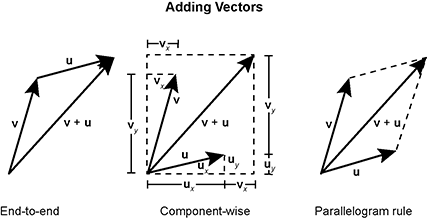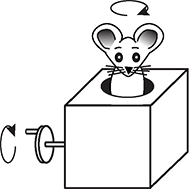Study Guide
Field 118: Technology Education
Recommendation for individuals using a screenreader: please set your punctuation settings to "most."
Sample Selected-Response Questions
Competency 0001
Fundamentals of Technology and Engineering Education
1. Use the information below to answer the question that follows.
A technology education teacher would like to integrate the content from the New York State P to 12 Learning Standards ( N Y S L S ) for Mathematics and the diagrams below into a class activity.
"Add vectors end-to-end, component-wise, and by the parallelogram rule."

Adding Vectors three ways to add two vectors first way is end to end technique vector v is the first vector the second vector is u and is placed with its tail at the tip of the head of vector v the resultant vector v plus u is set with its tail connected to vector v tail and its head connected to vector u head making a triangle the next technique is component wise all three vectors have their tails set at the same spot vector v is the top vector closer to the y axis and has a larger y value v sub y and a shorter x value v sub x the bottom vector u is set closer to the x axis with has a larger x value u sub x then y value u sub y the resulting vector v plus u is set between the two vectors with the x value being u sub x plus v sub x and the y value being u sub y plus v sub y the third technique is parallelogram rule vector v and vector u are two sides of a parallelogram and the resultant vect u plus v is the diagonal of that parallelogram
Which activity would be most appropriate for achieving this goal?
- Students will explore how the stress in a column depends on the area of the cross section.
- Students will explore how digital gates (e.g., start uppercase AND end uppercase , start uppercase OR end uppercase ) process digital signals.
- Students will explore the energy transformations that occur in a circuit consisting of a battery, a resistor, and an L E D.
- Students will explore the forces acting on a car traveling on a banked turn.
- Enter to expand or collapse answer. Answer expanded
- Correct Response: D. This question requires examinees to analyze the interrelationships between technology, engineering, science, mathematics, and other disciplines. Vectors are used in technology, engineering, science, and mathematics to represent quantities that have both magnitude and direction, such as force, velocity, and acceleration. Analysis of a transportation situation involving a car traveling on a banked curve makes use of force vectors, such as friction, normal force, centripetal force, and weight ( milligrams ). Determining the net force on the car requires that these forces be added using vector addition techniques, such as the end-to-end method, the component-wise method, or the parallelogram rule of vector addition.
Competency 0002
Technological and Engineering Design
2. Students are designing a linkage part for a pneumatic robotic arm. The students have identified several parameters in the design that are likely to need to be adjusted after testing. One advantage of using 3-D printing technology in this process is the ability to:
- create detailed orthographic and isometric drawings for visualizing the part's shape and dimensions.
- automatically convert C A D designs into G-code instructions for a C N C milling machine.
- transfer the dimensions and an identifying label to the contoured surfaces of each part to be tested.
- efficiently fabricate prototypes of a succession of functional parts for testing and redesigning.
- Enter to expand or collapse answer. Answer expanded
- Correct Response: D. This question requires examinees to identify the role of modeling, prototyping, iteration, optimization, and performance testing during design. A 3-D printer is an additive manufacturing technology and works by layering thin slices of a cross section of an object using liquid droplets that quickly solidify. During the design phase of a project, this technology supports the iterative design process by producing a low-cost artifact with relatively quick turnaround time. Using 3-D printing technology, a designer can have a computer-generated representation of an object translated into an actual model in a short amount of time.
Competency 0003
Manufacturing, Construction, and Materials
3. Which procedure for analyzing material properties is based on the principle that the motion of any wave will be affected by the medium through which it travels?
- ultrasonic testing
- destructive stress testing
- gas chromatography
- stress-strain analysis
- Enter to expand or collapse answer. Answer expanded
- Correct Response: A. This question requires examinees to apply procedures to analyze material properties. Ultrasonic testing is a form of nondestructive testing and is based on the behavior of high-frequency sound waves as they move through a material. This technology is useful for measuring material thickness and detecting cracks or other defects within a workpiece. An ultrasonic test device consists of a pulsed transmitter, transducer, and receiver, and makes use of an algorithm relating distance, time, speed, and other wave properties to provide information about the structure of the tested material.
Competency 0004
Information and Communication
4. Use the diagram below to answer the question that follows.

graph showing the amplitude on the y axis and time on the x axis for a recorded audio signal on the waveform there are several instances where the positive and negative peaks of the waveform are cut off or clipped showing a really high or low amplitude.
Students in a studio are making a digital live recording of a violinist playing classical music. After listening to the playback of a practice track, the students are dissatisfied with the audio fidelity. The diagram above shows a waveform of the recorded music. Which strategy is likely to be most effective in increasing the audio fidelity when making the final recording?
- increasing the digital sampling rate
- lowering the mixer input volume
- boosting the high-frequency levels
- decreasing the compression threshold
- Enter to expand or collapse answer. Answer expanded
- Correct Response: B. This question requires examinees to apply appropriate technologies used in electronic communication to encode information. The diagram shows the amplitude versus time for a recorded sample of an audio signal. For many portions of the displayed waveform, the positive and negative peaks are cut off or ?clipped? due to the amplitude, or volume, of the signal being set too high. Some of the audio information is lost, and the missing information diminishes the fidelity of the original audio content. This problem is corrected by decreasing the audio gain using the volume control during recording.
Competency 0005
Transportation and Energy
5. Use the diagram below to answer the question that follows.
When the crank on the toy shown in the diagram is turned in either direction, the mouse rotates either clockwise or counterclockwise. Which mechanism would be most appropriate for creating this outcome?
- lever and fulcrum
- worm-and-spur gear
- pulley and belt
- rack-and-pinion gear
- Enter to expand or collapse answer. Answer expanded
- Correct Response: B. This question requires examinees to analyze a variety of mechanical systems and devices. The toy in the diagram illustrates a system where rotary motion of a crank handle, the input, is translated into perpendicular rotary motion of the mouse at the output. A worm-and-spur gear is designed with a gear consisting of grooves cut into a rod that can be rotated, called the worm. The teeth of the spur gear mesh with the worm in an orientation that produces a 90-degree change in the direction of the rotation.
Competency 0006
Biotechnology and Environmental Quality
6. The production of high-quality biofuel is a multistep industrial procedure. In which initial biochemical process is plant material converted into ethanol?
- polymerization
- esterification
- fermentation
- distillation
- Enter to expand or collapse answer. Answer expanded
- Correct Response: C. This question requires examinees to apply knowledge of biotechnology, including techniques and processes that use living organisms to make or modify products. Ethanol is a form of alcohol that can be produced by the fermentation of carbohydrates contained in plant material. Typically, corn is used in this process. During fermentation, the starch contained in the corn is broken down into glucose, which with the action of yeast is converted into ethanol and carbon dioxide. The resulting ethanol is the biofuel, which is then mixed with gasoline in concentrations of 5 to 10 percent.
Acknowledgments
Item #1: From the New York State Education Department. New York State Next Generation Mathematics Learning Standards. Internet. Available from http://www.nysed.gov/curriculum-instruction/new-york-state-next-generation-mathematics-learning-standards; accessed 10/15/2018.

